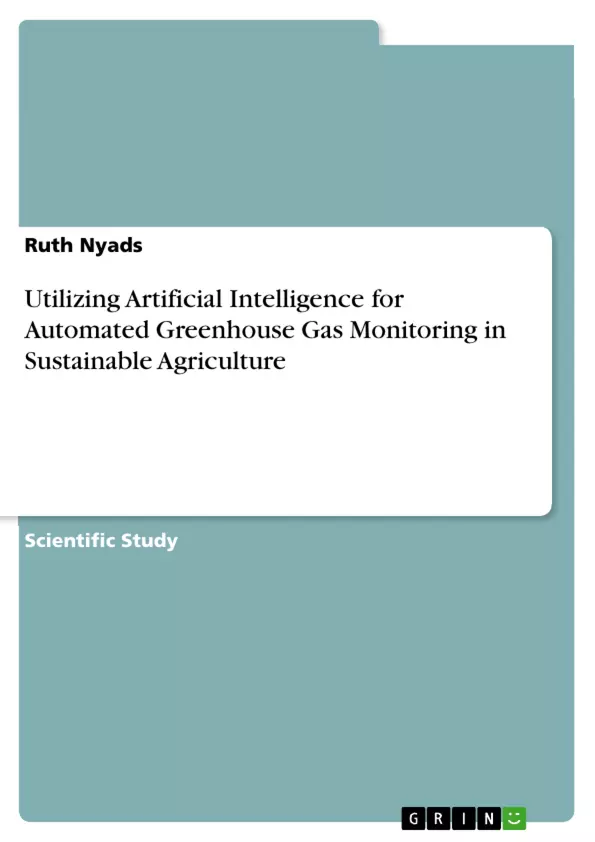This research focused on the application of AI to support automatic tracking of GHG emissions in the agricultural sector, one of the major contributors to emissions. The proposed system for GHG tracking was designed with IoT sensors, satellites, and record-keeping, making it scalable and efficient compared to previous methods. Some of the findings reveal that AI models are highly accurate in estimating emissions through models such as Gradient Boosting Machines, hence cutting down the cost of manual exercise by an average of 29.7%. Our analysis yields strong positive relationships between emissions and environmental conditions, especially soil moisture content. Nevertheless, such issues as data protection and integration, which are regarded as the major concerns in AI development, this research proves that AI in sustainable agriculture can be effective and beneficial in combating climate change and meeting environmental requirements.
Inhaltsverzeichnis (Table of Contents)
- I. Introduction
- II. Related Works
- III. Proposed Methodology
- IV. Evaluation
- V. Statistical Analysis
- VI. Conclusion
Zielsetzung und Themenschwerpunkte (Objectives and Key Themes)
This research aims to demonstrate the effectiveness of artificial intelligence (AI) in automating greenhouse gas (GHG) monitoring within sustainable agriculture. The study explores the feasibility and benefits of using AI-powered systems, integrating IoT sensors, satellite data, and existing records, to improve the accuracy and efficiency of GHG emission tracking compared to traditional methods.
- Application of AI in automated GHG monitoring in agriculture
- Accuracy and cost-effectiveness of AI-based emission estimation models
- Relationship between GHG emissions and environmental factors
- Challenges in data acquisition, integration, and AI scalability in agriculture
- Potential of AI for climate change mitigation and sustainable agricultural practices
Zusammenfassung der Kapitel (Chapter Summaries)
I. Introduction: This chapter introduces the critical role of agriculture in global food production while highlighting its significant contribution to greenhouse gas emissions. It emphasizes the limitations of traditional GHG monitoring methods, such as their high cost, time consumption, and inaccuracy, particularly in diverse agricultural settings and developing countries. The chapter then positions AI as a potential solution, emphasizing its ability to handle large datasets from various sources (IoT sensors, satellite imagery, historical records) and analyze emission patterns to improve monitoring accuracy and efficiency. The introduction also briefly outlines the challenges associated with implementing AI solutions in agriculture, including data accessibility, scalability issues, and integration with existing farming practices.
II. Related Works: [This section would contain a summary of existing literature reviewed. Since no such literature is provided in the given text, a summary cannot be created.]
III. Proposed Methodology: [This section would detail the methodology used in the research. Since the methodology is not described in the provided text, a summary cannot be created.]
IV. Evaluation: [This section would present the results of the evaluation of the proposed methodology. Since no evaluation results are provided in the given text, a summary cannot be created.]
V. Statistical Analysis: [This section would detail the statistical analysis performed. Since no statistical analysis is detailed in the provided text, a summary cannot be created.]
Schlüsselwörter (Keywords)
Artificial Intelligence, Greenhouse Gas Monitoring, Sustainable Agriculture, IoT Sensors, Climate Change Mitigation, GHG Emissions, AI Models, Data Analysis, Precision Agriculture.
Frequently asked questions
What is the main topic of the document?
The document provides an overview of a research project focused on using artificial intelligence (AI) for automating greenhouse gas (GHG) monitoring within sustainable agriculture. It includes the title, table of contents, objectives and key themes, chapter summaries, and key words.
What is the research trying to achieve?
The research aims to demonstrate the effectiveness of AI in automating GHG monitoring, explore the feasibility and benefits of using AI-powered systems, and improve the accuracy and efficiency of GHG emission tracking.
What are the key themes explored in the research?
The key themes include the application of AI in automated GHG monitoring, the accuracy and cost-effectiveness of AI-based emission estimation models, the relationship between GHG emissions and environmental factors, the challenges in data acquisition and integration, and the potential of AI for climate change mitigation.
What is covered in the Introduction chapter?
The Introduction chapter introduces the role of agriculture in food production and its contribution to GHG emissions. It highlights the limitations of traditional monitoring methods and positions AI as a potential solution. It also outlines challenges associated with implementing AI solutions in agriculture.
What other sections will be included in the research?
Other sections that were intended to be included were Related Works, Proposed Methodology, Evaluation, and Statistical Analysis.
What are the keywords associated with the research?
The keywords are Artificial Intelligence, Greenhouse Gas Monitoring, Sustainable Agriculture, IoT Sensors, Climate Change Mitigation, GHG Emissions, AI Models, Data Analysis, and Precision Agriculture.
- Quote paper
- Ruth Nyads (Author), 2024, Utilizing Artificial Intelligence for Automated Greenhouse Gas Monitoring in Sustainable Agriculture, Munich, GRIN Verlag, https://www.hausarbeiten.de/document/1555534


